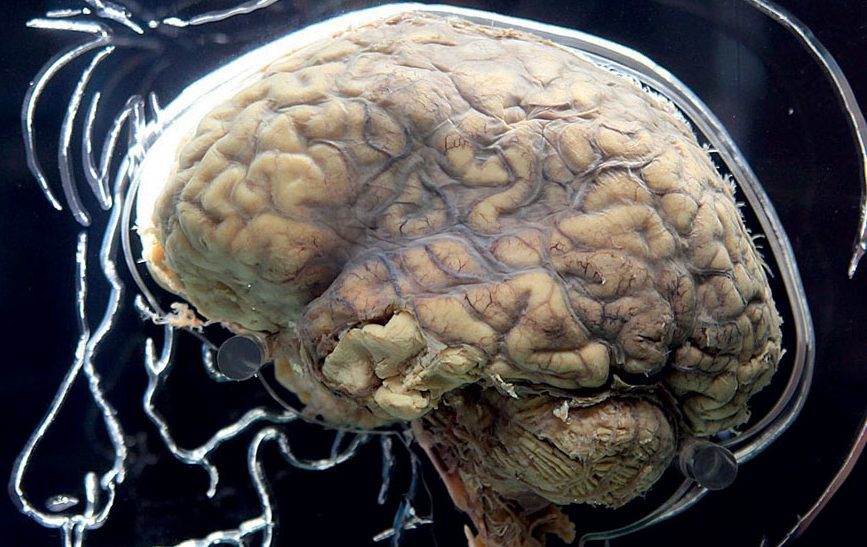Creutzfeldt-Jakob disease: what is it, symptoms, treatment, prognosis
Content
- What is Creutzfeldt-Jakob disease?
- Prions
- Types of Creutzfeldt-Jakob disease
- Symptoms and stages
- Early stages
- Later stages
- Causes of Creutzfeldt-Jakob disease
- The role of proteins in the brain
- When protein folding is not going well
- Sporadic (classical) form
- New variant
- Iatrogenic form
- Hereditary form of the disease
- Can Creutzfeldt-Jakob disease spread from person to person?
- Diagnostics
- Checking for common symptoms
- Brain biopsy
- Treatment
- Team of specialists
- Care and support
- Forecast
- Prophylaxis
What is Creutzfeldt-Jakob disease?
Creutzfeldt-Jakob disease (Creutzfeldt-Jakob disease, CJD) is a rare neurological disease (nervous system disorder) that causes brain damage.
It belongs to a group of diseases called transmissible spongiform encephalopathies., or prion diseases that affect humans and animals.
CJD is fatal, and there is no cure, if only symptomatic. Disease is caused by an abnormal protein called a prion that pollutes the nervous system.
Prions

Prions are infectious particles made of abnormally folded protein. In some ways, a prion is similar to a virus in that it can multiply and cause disease. But unlike a virus, it is made entirely of protein and has no genetic material.
This makes prions much tougher than viruses or bacteria. They can withstand extreme temperatures and radiation, and are resistant to breakdown by enzymes that normally control protein levels in the body. Antibiotics and antiviral drugs do not affect them.
Prions kill brain cells and create holes in the brain, giving them a spongy appearance.
Types of Creutzfeldt-Jakob disease
There are 4 different types of Creutzfeldt-Jakob disease, each with a different cause:
- Sporadic (sCJD) is the most common form, accounting for 85% of cases. The cause is unknown, but usually affects people over 40.
- A new variant (nvCJD) was first identified in 1996. nvCJD is caused by the consumption of bovine meat infected with mad cow disease. nvCJD mainly affects people in their 20s.
- Iatrogenic form (1CJD) - the infection is transmitted from a person with the disease through medical or surgical treatment. His cases are extremely rare these days.
- Hereditary form (fCJD) is a rare form of prion disease caused by the inheritance of a defective prion-producing gene.
Symptoms and stages

The symptoms and course of Creutzfeldt-Jakob disease differ depending on the type. However, all four types of the disease share some of the same features, described below.
Early stages
Creutzfeldt-Jakob disease usually begins with emotional or behavioral problems such as depression, restlessness, or agitation.
Delirium (strong beliefs about things that are clearly not true) and hallucinations (seeing or hearing things that are not) are typical of the new variant of the disease (nvCJD).
Patients also develop neurological problems (affecting the nervous system) such as pain or numbness in parts of the body.
Within a few weeks, the person rapidly deteriorates, becomes confused, and experiences memory loss (symptoms typical of dementia).
Later stages
Along with confusion and memory loss, a person can lose coordination and balance and start to go blind.
Months later, patients are unable to walk, talk, or take care of themselves. They are unaware of their surroundings and develop jerky muscle movements.
Read also:Tension-type headache
Three quarters of people with sporadic (classic) Creutzfeldt-Jakob disease die within six months of diagnosis, often from pneumonia infection. Others die within a few weeks.
Causes of Creutzfeldt-Jakob disease

The disease is caused by an infectious protein in the brain called a prion.
The role of proteins in the brain
Proteins are molecules made of amino acids that help our body's cells to function.
Proteins start out as a chain of amino acids that then fold into a three-dimensional shape. This “protein folding” (protein folding) allows them to perform useful functions in our cells.
Prion proteins (which are not the same infectious prions that cause UPC, i.e. normal prion proteins) are a type of protein found in the brain and some other tissues of the nervous systems. The exact role of prion proteins in the brain is unknown, but it is believed that they may have something to do with long-term memory.
When protein folding is not going well
Sometimes errors occur during protein folding, as a result of which the prion protein cannot be used by the body. These misfolded prion proteins are usually processed by the body, but sometimes they can build up, which can cause problems such as Alzheimer's disease.
Prions are misfolded prion proteins that enter brain cells and also cause normal proteins to not fold properly. This causes brain cells to die, releasing more prions, infecting other brain cells.
Eventually, the clusters of brain cells die and are replaced by prion deposits called plaques. These plaques produce small holes in the brain, giving it a spongy appearance. Brain damage causes mental and physical impairment and possible disease-related death.
Prions can live in nerve tissue (in the brain or spinal cord) for a very long time, even after the death of a person or animal.
Sporadic (classical) form
Sporadic BJD (sCJD) is the most common type of the disease, although it is still very rare. It is not known what causes sCJD, but it may be due to the fact that a normal protein spontaneously turns into a prion or a normal gene spontaneously turns into a defective gene producing prions. sCJD usually affects people over the age of 40.
New variant

There is clear evidence that the new variant BJD (vCJD) is caused by the same prion strain as bovine spongiform encephalopathy (also known as mad cow disease).
A 2000 UK government study concluded that the prion spread through cattle fed a meat-and-bone mixture containing traces of an infected brain or spinal cord brain. The prion then ended up in processed meats like beefburgers and entered the human food chain.
Iatrogenic form
The iatrogenic form of the disease is the result of transmission from a person with UCD through medical or surgical treatment.
Most iatrogenic cases of Creutzfeldt-Jakob disease (1CJD) have occurred with the use of human growth hormone, which has been used to treat children with limited growth. Between 1958 and 1985, thousands of children were treated with a hormone that was extracted from the pituitary gland (the gland at the base of the skull) of human cadavers at the time. A tiny minority of these children developed UCB because the hormones they received were taken from the glands of infected people.
Read also:Sciatic nerve inflammation, causes, symptoms and home treatment
Several other cases of 1CJD have occurred when people received infected tissue transplants or came into contact with surgical instruments that were infected with Creutzfeldt-Jakob disease. This was due to the fact that prions are tougher than viruses or bacteria, so the normal process of sterilizing surgical instruments did not work.
Hereditary form of the disease
This very rare form of the disease is caused by an inherited mutation (defect) in a gene that makes normal proteins. The altered gene appears to be producing prions that cause OUC.
Each has two copies of their genes, but the mutated gene is dominant. This means that a person only needs to inherit one mutated gene for the disease to develop.
Can Creutzfeldt-Jakob disease spread from person to person?
In theory, the disease can be transmitted from a sick person to others, but only through injection or consumption of brain tissue.
Creutzfeldt-Jakob disease is believed to be not transmitted with normal daily contact with patients or airborne droplets, blood contact or sexual contact.
Diagnostics
Diagnosis is usually based on medical history, symptoms, and a series of tests. below). A neurologist (a doctor who specializes in conditions of the nervous system) will do tests to rule out other conditions with similar symptoms, such as Alzheimer's disease, Parkinson's disease or a brain tumor.
The only way to confirm the diagnosis of Creutzfeldt-Jakob disease is to directly examine the brain tissue with a brain biopsy (see below). below) or, if the person died, after an autopsy.
Checking for common symptoms
A clinical neurologist will rule out other conditions with similar symptoms and check for some common signs of illness by performing any of the following tests:
- Magnetic resonance imaging (MRI) of the brain. It uses strong magnetic fields and radio waves to produce a detailed image of the brain, and can detect abnormalities that are characteristic of the BLU.
- Electroencephalogram (EEG). The study records brain activity and can detect abnormal electrical patterns seen in sporadic FNC.
- Lumbar puncture. A needle is inserted into the lower part of the spine to take a sample of the cerebrospinal fluid (which surrounds the brain and spinal cord) for examination in a laboratory. If a protein called 14-3-3 is found in the fluid, this indicates that the person may have a disease Creutzfeldt-Jakob (this protein is found in almost all cases of the classic form of the disease and in 50% of cases of a new variant of the disease).
- Tonsil biopsy. A small piece of tissue is taken from the tonsils and checked for the presence of abnormal prions found in the new version of the BLR (they are not in other types).
- Genetic test. This is a simple blood test to see if there is a mutation (error) in a gene that makes a normal protein. A positive result may indicate a hereditary form of the disease.
Brain biopsy
During a brain biopsy, the surgeon drills a tiny hole in the skull and removes a small piece of brain tissue with a very fine needle. This is done under general anesthesia (the person is asleep).
Read also:Aphasia
Because a brain biopsy carries the risk of causing brain damage or seizures (epilepsy), it is only done in several cases where there is a fear that the patient does not have Creutzfeldt-Jakob disease, but there is some other treatable condition.
Treatment
There is no proven therapy or cure for any form of Creutzfeldt-Jakob disease.
Many potential therapeutic interventions for disease are currently under discussion.
Treatment involves trying to keep the person as comfortable as possible for a short life and to reduce symptoms with medication. For example:
- Psychological symptoms such as anxiety and depression can be treated with sedatives and antidepressants.
- Other medicines, such as clonazepam and sodium valproate, can be used to treat muscles and tremors.
- Opiate pain relievers can provide effective pain relief.
Team of specialists
When someone is diagnosed with BJC, they are referred to the appropriate center for diagnosis and treatment. A physician and nurse from these services will be assigned to the patient to liaise with local services such as a general practitioner, social worker, physical therapist and occupational therapist.
Teams of specialists are available to diagnose and provide clinical and emotional support to patients and their families, as well as work with the local care team. The local care team may include doctors and nurses, occupational health professionals, nutritionists, incontinence counselors and social workers.
Care and support
As the disease progresses, people with Creutzfeldt-Jakob disease will need significant care and practical support.
In addition to helping with feeding, washing, and getting around, some people may need help urinating. The use of a catheter (a tube that is inserted into the bladder and used to drain urine) is often required.
Many people have trouble swallowing and may need to eat and drink through a feeding tube.
It may be possible to treat people with BLU at home, but this will depend on the progression and severity of the disease.
The pressure of caring for someone with a BJC can be difficult. Rather than dealing with the problem at home, many carers choose to use hospital services.
Forecast
There is no cure for CJD. The disease quickly worsens the person's condition to the point that they can no longer take care of themselves and can no longer move or speak.
Most people with sporadic CJD die within 6 months of diagnosis, often from pneumonia. People with the new variant of the disease live on average a little over a year.
Prophylaxis
Since the link between mad cow disease and Creutzfeldt-Jakob disease has been confirmed, prevent the development of diseases will be helped by high-quality heat treatment of animal meat, as well as an increase in the immune system organism.



